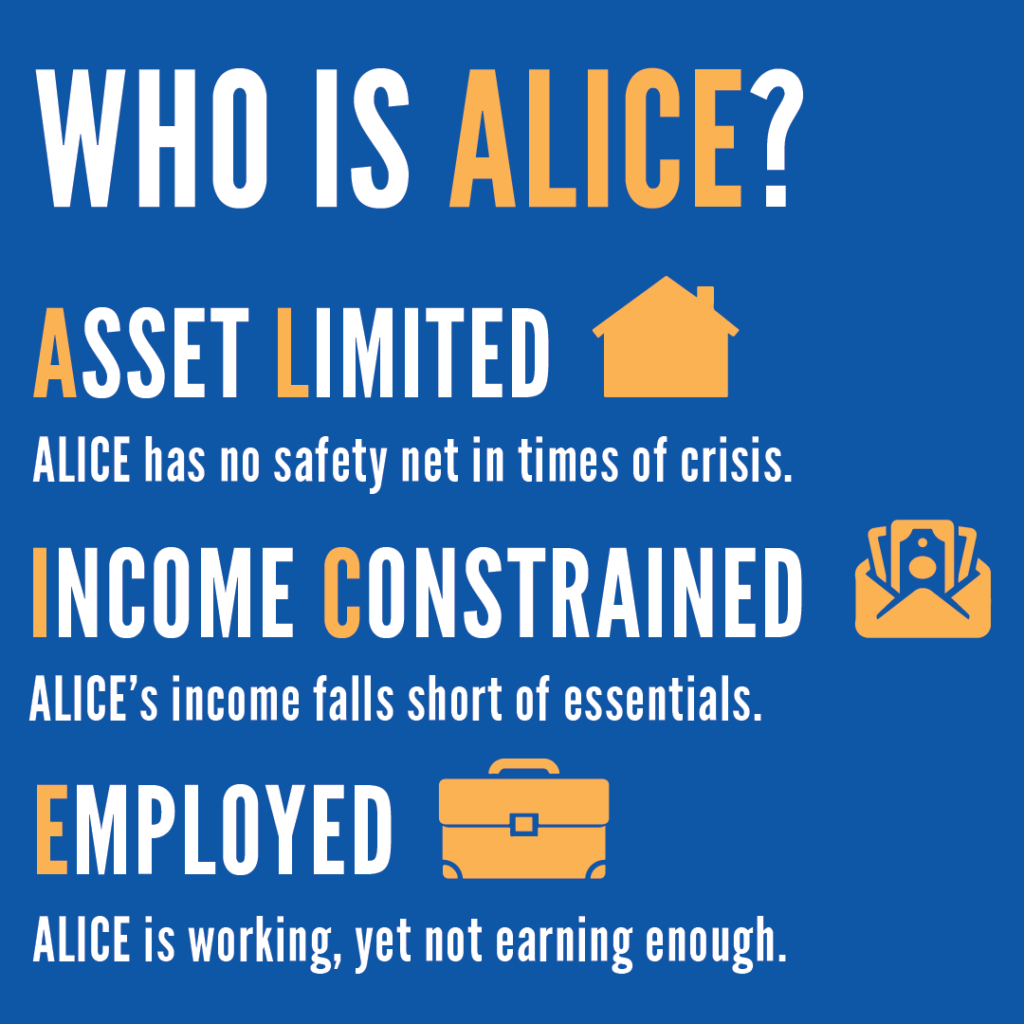Though wages for the lowest paid jobs have risen across the country at the fastest rate in four decades, the number of households struggling to get by in Maine grew nearly 7,000 from 2021 to 2022. As a result, a total of 249,725 households (or 42%) were living paycheck to paycheck, according to a new Update from United Ways of Maine and its research partner United For ALICE.
That calculation includes the 70,445 Maine households in poverty as well as another 179,280 defined as ALICE (Asset Limited, Income Constrained, Employed), earning above the Federal Poverty Level but less than what’s needed to survive in the current economy. ALICE workers include child care providers, home health aides and cashiers — those working low-wage jobs, with little or no savings and one emergency from poverty.
ALICE in the Crosscurrents: An Update on Financial Hardship in Maine shows that while wages were increasing, so too were costs. For a family of four with an infant and a preschooler, the basic costs to live and work in Maine, excluding tax credits, rose from $87,468 in 2021 to $91,536 a year later. Compounding the issue in 2022 was the loss of up to $15,000 in federal child tax credits and stimulus payments that this family had access to in 2021.
“There is no doubt, bigger paychecks helped, but inflation and the loss of pandemic supports converged to keep ALICE trapped,” said Dan Coyne, senior vice president, community impact and governance at United Way of Southern Maine. “This latest data is a reminder that while we have made some progress, our work is far from over.”
The findings in this one-year period are consistent with a more than decade-long trend: Since the end of the Great Recession, despite some ups and downs, the number of ALICE households in Maine has been steadily growing. From 2010 to 2022, the total number of households rose by 9%, households in poverty remained flat — and the number of ALICE households grew by 29%.
“The data is showing persistent and widespread financial hardship — a red flag that the current system isn’t working for ALICE,” said Stephanie Hoopes, Ph.D., United For ALICE National Director. “Current policy has not been enough to break down the barriers that trap ALICE households in financial hardship, from lack of access to housing and child care that’s affordable, to inadequate community supports such as broadband internet.”
Additional insights include:
- From 2010 to 2022, people ages 65 and over made up the fastest-growing age group in Maine — and the group with the largest increase (46%) in the number of households struggling to make ends meet.
- Racial disparities persisted in the rates of financial hardship; 57% of Black and 51% of American Indian/Alaska Native households Maine were either in poverty or ALICE in 2022, compared to 41% of white households.
- Food assistance continued to elude many vulnerable families in Maine. Partly due to the SNAP income eligibility level in the state (185% of the Federal Poverty Level), only 40% of all Maine households in poverty and 18% of all ALICE households participated in SNAP in 2022.
To read the Update and access online, interactive dashboards that provide data on financial hardship at the state, county, and local levels, visit aliceinmaine.org.
About United Ways of Maine
United Ways of Maine’s mission is to improve lives and create lasting positive change across Maine, by supporting a strong network of local United Ways. There are seven United Ways of Maine (UWME), each independently incorporated, and each governed by local volunteers. UWME partners with individuals, schools, nonprofit organizations, government policymakers, businesses, financial institutions, voluntary neighborhood associations, community development corporations, and the faith community. We have a keen appreciation for the uniqueness of each community in Maine and do not waver in our respect for the local nature and independent governance of each United Way. For more information, visit: unitedwaysofmaine.org.
About United For ALICE
United For ALICE is a U.S. research organization driving innovation, research, and action to improve life across the country for ALICE (Asset Limited, Income Constrained, Employed) and for all. Through the development of the ALICE measurements, a comprehensive, unbiased picture of financial hardship has emerged. Harnessing this data and research on the mismatch between low-paying jobs and the cost of survival, ALICE partners convene, advocate, and collaborate on solutions that promote financial stability at local, state, and national levels. This grassroots ALICE movement, led by United Way of Northern New Jersey, has spread to 31 states and includes United Ways, corporations, nonprofits and foundations in Arkansas, Colorado, Connecticut, Delaware, Florida, Georgia, Hawai‘i, Idaho, Illinois, Indiana, Iowa, Kansas, Louisiana, Maine, Maryland, Michigan, Minnesota, Mississippi, New Jersey, New York, North Carolina, Ohio, Oregon, Pennsylvania, South Carolina, Tennessee, Texas, Virginia, Washington, Washington, D.C., West Virginia, and Wisconsin; we are United For ALICE. For more information, visit: UnitedForALICE.org.
